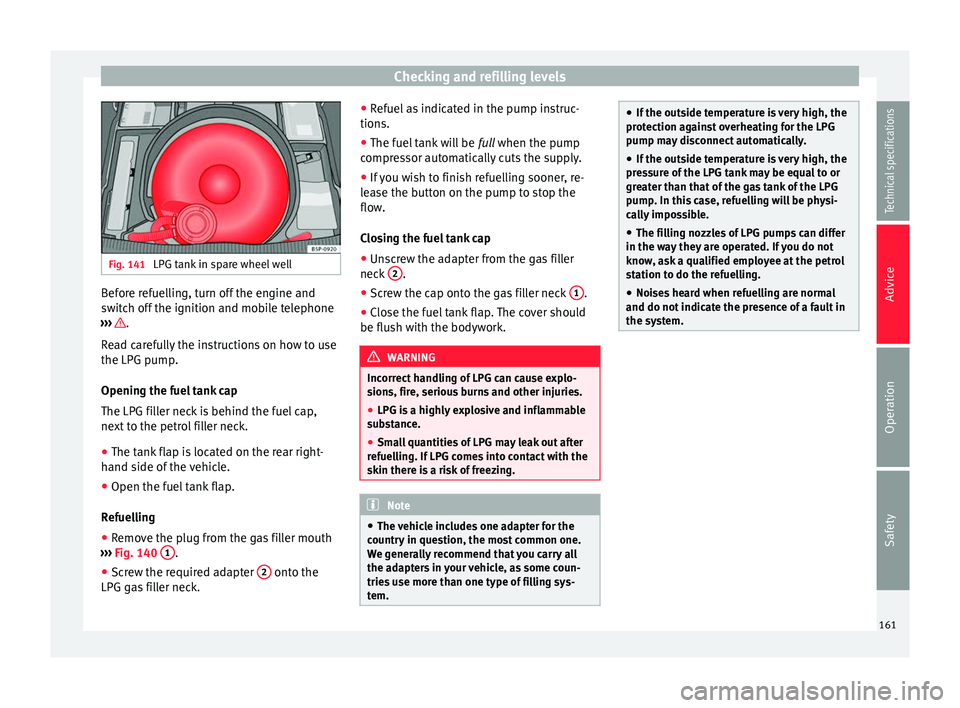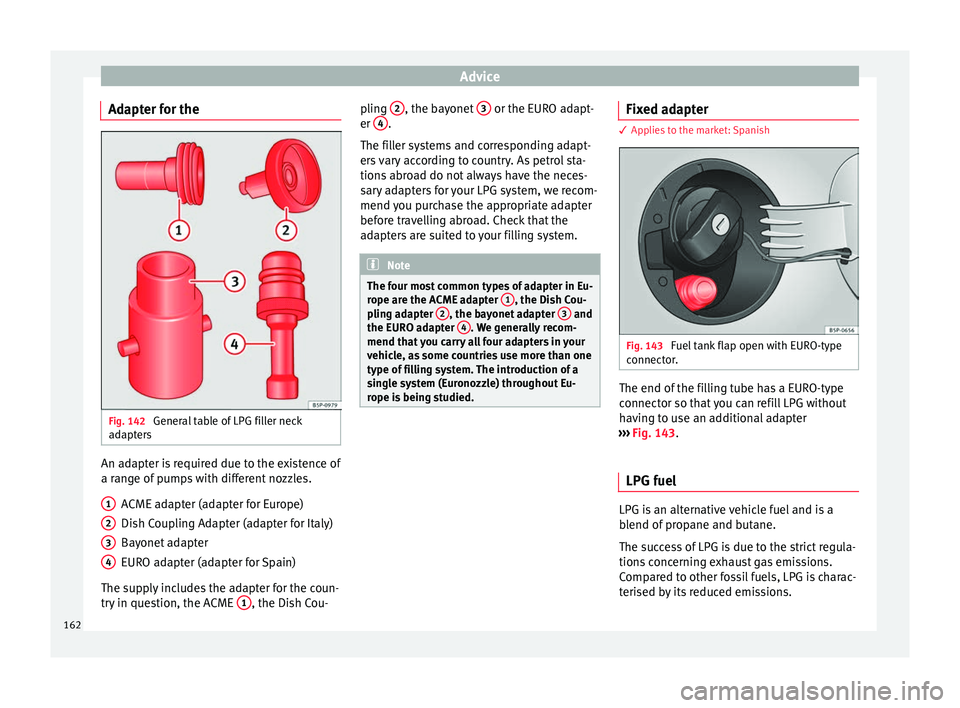2015 Seat Altea XL fuel pump
[x] Cancel search: fuel pumpPage 123 of 236

Driving
WARNING
● The ignition key must NOT be removed from
the lock until the vehicle comes to a stand-
still. Otherwise, the steering could be imme-
diately blocked- Risk of accident!
● Always remove the key from the ignition
when leaving the vehicle, even if only for a
short period. This is especially important if
children or disabled people are left alone in
the vehicle. They could accidentally start the
engine or work electrical equipment such as
the electric windows, resulting in an acci-
dent.
● Unsupervised use of the key could start the
engine or any electrical system, such as the
electric windows. This could result in serious
injury. CAUTION
The starter motor will only work when the en-
gine is stopped (ignition key position 2 ).
Electronic immobiliser
The electronic immobiliser prevents unau-
thorised persons from driving the vehicle.
Inside the key there is a chip that deactivates
the electronic immobiliser automatically
when the key is inserted into the ignition. The electronic immobiliser will be activated
again automatically as soon as you pull the
key out of the ignition lock.
The engine can only be started using a genu-
ine SEAT key with its correct code.
Note
A perfect operation of the vehicle is ensured
if genuine SEAT keys are used. Starting petrol engines
The engine can only be started using a genu-
ine SEAT key with its correct code.
– Move the gearbox lever to the neutral posi-
tion and depress the clutch pedal thor-
oughly and hold it in this position for the
starter to turn the engine on.
– Turn the ignition key to the starting posi-
tion ›››
page 120 .
– Let
go of the ignition key as soon as the en-
gine starts; the starter motor must not run
on with the engine.
After starting a very hot engine, you may
need to slightly press down the accelerator.
When starting a cold engine, it may be a little
noisy for the first few seconds until oil pres-
sure has built up in the hydraulic valve com-
pensators. This is quite normal, and no cause
for concern. If the engine does not start immediately,
switch the starter off after 10 seconds and try
again after half a minute. If the engine still
does not start, the fuel pump fuse should be
checked
››› page 196, Fuses. WARNING
● Never start or run the engine in unventila-
ted or closed rooms. The exhaust gases con-
tain carbon monoxide, an odourless and col-
ourless poisonous gas. Risk of fatal acci-
dents. Carbon monoxide can cause loss of
consciousness and result in death.
● Never leave the vehicle unattended if the
engine is running.
● Never use “cold start sprays”, they could
explode or cause the engine to run at high
revs. Risk of injury. CAUTION
● When the engine is cold, you should avoid
high engine speeds, driving at full throttle
and over-loading the engine. Risk of engine
damage.
● The vehicle should not be pushed or towed
more than 50 metres to start the engine. Un-
burnt fuel could enter the catalytic converter
and damage it.
● Before attempting to push-start or tow a ve-
hicle in order to start it, you should first try to
start it using the battery of another vehicle.
Note and follow the instructions in
››› page 189, Jump-starting.
» 121
Technical specifications
Advice
Operation
Safety
Page 163 of 236

Checking and refilling levels
Fig. 141
LPG tank in spare wheel well Before refuelling, turn off the engine and
switch off the ignition and mobile telephone
››› .
Read carefully the instructions on how to use
the LPG pump.
Opening the fuel tank cap
The LPG filler neck is behind the fuel cap,
next to the petrol filler neck.
● The tank flap is located on the rear right-
hand side of the vehicle.
● Open the fuel tank flap.
Refuelling
● Remove the plug from the gas filler mouth
››› Fig. 140 1 .
● Screw the required adapter 2 onto the
LPG gas filler neck. ●
Refuel as indicated in the pump instruc-
tions.
● The fuel tank will be full when the pump
c ompr
essor automatically cuts the supply.
● If you wish to finish refuelling sooner, re-
lease the button on the pump to stop the
flow.
Closing the fuel tank cap
● Unscrew the adapter from the gas filler
neck 2 .
● Screw the cap onto the gas filler neck 1 .
● Close the fuel tank flap. The cover should
be flush with the bodywork. WARNING
Incorrect handling of LPG can cause explo-
sions, fire, serious burns and other injuries.
● LPG is a highly explosive and inflammable
substance.
● Small quantities of LPG may leak out after
refuelling. If LPG comes into contact with the
skin there is a risk of freezing. Note
● The vehicle includes one adapter for the
country in question, the most common one.
We generally recommend that you carry all
the adapters in your vehicle, as some coun-
tries use more than one type of filling sys-
tem. ●
If the outside temperature is very high, the
protection against overheating for the LPG
pump may disconnect automatically.
● If the outside temperature is very high, the
pressure of the LPG tank may be equal to or
greater than that of the gas tank of the LPG
pump. In this case, refuelling will be physi-
cally impossible.
● The filling nozzles of LPG pumps can differ
in the way they are operated. If you do not
know, ask a qualified employee at the petrol
station to do the refuelling.
● Noises heard when refuelling are normal
and do not indicate the presence of a fault in
the system. 161
Technical specifications
Advice
Operation
Safety
Page 164 of 236

Advice
Adapter for the Fig. 142
General table of LPG filler neck
adapters An adapter is required due to the existence of
a range of pumps with different nozzles.
ACME adapter (adapter for Europe)
Dish Coupling Adapter (adapter for Italy)
Bayonet adapter
EURO adapter (adapter for Spain)
The supply includes the adapter for the coun-
try in question, the ACME 1 , the Dish Cou-
1 2
3
4 pling
2 , the bayonet
3 or the EURO adapt-
er 4 .
The filler systems and corresponding adapt-
ers vary according to country. As petrol sta-
tions abroad do not always have the neces-
sary adapters for your LPG system, we recom-
mend you purchase the appropriate adapter
before travelling abroad. Check that the
adapters are suited to your filling system. Note
The four most common types of adapter in Eu-
rope are the ACME adapter 1 , the Dish Cou-
pling adapter 2 , the bayonet adapter
3 and
the EURO adapter 4 . We generally recom-
mend that you carry all four adapters in your
vehicle, as some countries use more than one
type of filling system. The introduction of a
single system (Euronozzle) throughout Eu-
rope is being studied. Fixed adapter
3 Applies to the market: Spanish
Fig. 143
Fuel tank flap open with EURO-type
connector. The end of the filling tube has a EURO-type
connector so that you can refill LPG without
having to use an additional adapter
››› Fig. 143 .
LPG f uel LPG is an alternative vehicle fuel and is a
blend of propane and butane.
The success of LPG is due to the strict regula-
tions concerning exhaust gas emissions.
Compared to other fossil fuels, LPG is charac-
terised by its reduced emissions.
162